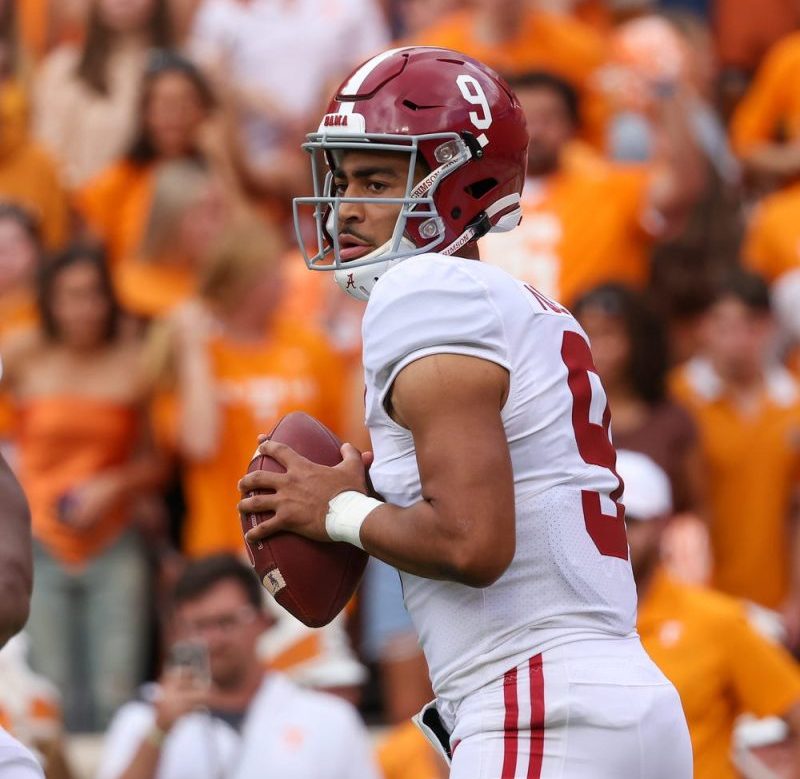Alabama football quarterback Bryce Young was standing in the pocket in the second quarter of Saturday’s 52-49 loss at Tennessee and launched a pass.
Within a second after Young threw it, Omari Thomas crashed into the quarterback, the Tennessee defensive lineman’s helmet making contact with Young’s helmet, specifically the facemask. Thomas knocked him to the ground in the process.
The hit on Young was reviewed for targeting, but the officials determined a penalty would not be called.
As No. 6 Alabama (6-1, 3-1 SEC) faces No. 24 Mississippi State (5-2, 2-2) on Saturday (7 p.m. ET, ESPN) at Bryant-Denny Stadium for this season’s homecoming game, Crimson Tide coach Nick Saban said he was not given an explanation on the play.
‘We turned the plays in,’ Saban said Monday. ‘I’m sure the league office will look at it and make a determination. There’s two things that are an issue here: targeting, but you’re also not supposed to hit the quarterback in the head. Last year against Texas A&M, Malachi (Moore) got thrown out of the game. The guy was out of the pocket, jumped up to block the ball and ended up, almost accidentally, hitting him in the head and got ejected from the game. So there’s really two things that should be looked at.”
Follow every game: Live NCAA College Football Scores
Thomas said postgame he didn’t know the play was being reviewed until defensive line coach Rodney Garner told him.
‘I didn’t really feel like I did anything because we’re not going out here to purposefully hurt anyone,’ Thomas said. ‘I was just trying to make a good football play and get a good hit on the quarterback.’
As for the targeting play against the Aggies in 2021, it occurred when Moore hit Zach Calzada. After Calzada got rid of the ball, Moore gave Calzada a shiver that involved contact to the helmet. Moore was ejected from the game, as it was ruled targeting.
What is targeting?
The 2022 NCAA football rulebook discusses targeting in Rule 9, Section 1, Articles 3 and 4.
Here’s what it says about targeting and making forcible contact to head or neck area of a defenseless player. Young fit in that category because he was ‘a player in the act of or just after throwing a pass.’
Article 4 defines the rule, saying that ‘no player shall target and make forcible contact to the head or neck area of a defenseless opponent with the helmet, forearm, hand, fist, elbow or shoulder. This foul requires that there be at least one indicator of targeting. When in question, it is a foul.’
Here is the full explanation of the targeting indicators, via the rule book:
“Targeting” means that a player takes aim at an opponent for purposes of attacking with forcible contact that goes beyond making a legal tackle or a legal block or playing the ball. Some indicators of targeting include but are notlimited to:
Launch. A player leaving their feet to attack an opponent by an upward and forward thrust of the body to make forcible contact in the head or neck area.A crouch followed by an upward and forward thrust to attack with forcible contact at the head or neck area, even though one or both feet are still on the ground.Leading with helmet, shoulder, forearm, fist, hand or elbow to attack with forcible contact at the head or neck area.Lowering the head before attacking by initiating forcible contact with the crown of the helmet.
Young was returning from a shoulder injury he suffered on Oct. 1 in the second quarter against Arkansas, which forced him out of the rest of that game, and the team’s game vs. Texas A&M on Oct. 8.
Young showed no signs of limitation in his return, however. He passed for 455 yards and two touchdowns, completing 35 of 52 pass attempts.
‘I think the way our medical staff managed that gave him the best opportunity to do it, and obviously came through and played really well today,’ Saban said postgame.

